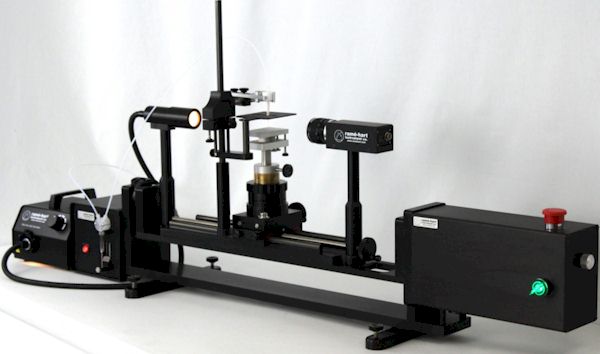|
January 2025 |
| The Role of Contact Angle in Designing Functional Fabrics |
|
The contact angle, a key parameter in
surface science, measures the wettability of a material by gauging
the angle formed at the junction where a liquid droplet meets a
solid surface. This seemingly simple metric plays a pivotal role in
designing fabrics and textiles, particularly in ensuring specific
functional properties such as water-resistance, stain repellence,
and moisture-wicking capabilities. Fabrics designed to repel water, such as those used in outdoor gear or rainwear, rely heavily on high contact angles, also known as superhydrophobicity. A high contact angle indicates that water beads up and rolls off the fabric instead of soaking in, a feature often achieved by coating the fabric with hydrophobic materials or structuring its surface to mimic the lotus effect.1
In contrast, sportswear and performance textiles are engineered for low contact angles with water. This ensures that moisture spreads quickly across the fabric’s surface, enabling rapid evaporation and keeping the wearer dry and comfortable. Researchers in Hong Kong have developed a superhydrophilic fabric which, in addition to providing ultra fast liquid transportation, can output electrical energy.2 High contact angles also help prevent liquids like coffee or wine from seeping into the fabric, making stain-resistant textiles possible. This is particularly useful in home furnishings and clothing. Fabrics that combine water-resistance with breathability, such as Gore-Tex, achieve a delicate balance of contact angle optimization. The microstructure of such materials allows water vapor (from sweat) to pass through while repelling liquid water. There are some challenges in measuring contact angle on fabrics and textiles. Many textiles are porous, causing liquid droplets to penetrate the material instead of resting on the surface. This makes traditional contact angle measurements less reliable. Likewise, fabrics often have rough or irregular surfaces, which can distort the apparent contact angle by creating multiple points of contact for the liquid droplet. Unlike rigid materials, fabrics are soft and can deform under the weight of the liquid droplet, altering the contact angle. Some fabrics are treated with coatings or finishes that may wear unevenly, leading to variability in contact angle measurements. Using a ramé-hart goniometer with DROPimage software can help accurately determine the contact angle, even on rough or porous surfaces. For fabrics with high porosity or roughness, the tilting plate method—measuring the angle at which a droplet begins to slide—can provide insights into wettability beyond static contact angle measurements. This can be done with any ramé-hart instrument with a manual or Automated Tilting Base. Additionally, modifying the traditional sessile drop method to account for liquid absorption over time can yield more meaningful data for porous textiles. Ensuring consistent fabric tension and surface treatment during measurements can reduce variability and improve accuracy. By using optional ramé-hart Film Clamps, the fabric sample can be secured flat on the stage with uniform tension for more repeatable output data.
Measuring advancing and receding contact angles—which represent the maximum and minimum angles a liquid droplet makes as it spreads or retracts—can provide a more comprehensive picture of wettability, with their difference (contact angle hysteresis) offering insights into surface uniformity and liquid adhesion, critical factors for designing functional fabrics. The ramé-hart Automated Tilting Base is especially useful for this task although the add/remove volume method can also be used with the ramé-hart Automated Dispensing System. Understanding and measuring the contact angle is critical in the design and optimization of functional fabrics and textiles. Whether the goal is to create waterproof rainwear, moisture-wicking athletic gear, or stain-resistant upholstery, the contact angle offers a direct link between material properties and performance. By addressing the unique challenges of measuring contact angle on fabrics, researchers and manufacturers can continue to innovate, ensuring that the textiles of tomorrow meet the evolving demands of consumers. Notes |
| Happy New Year |
| All of us at ramé-hart instrument co. wish you a happy and prosperous New Year! If we can assist you in 2025 with your existing ramé-hart product or if you're exploring options for a new goniometer / tensiometer, please don't hesitate to reach out. |
|
Regards,
Carl Clegg |


